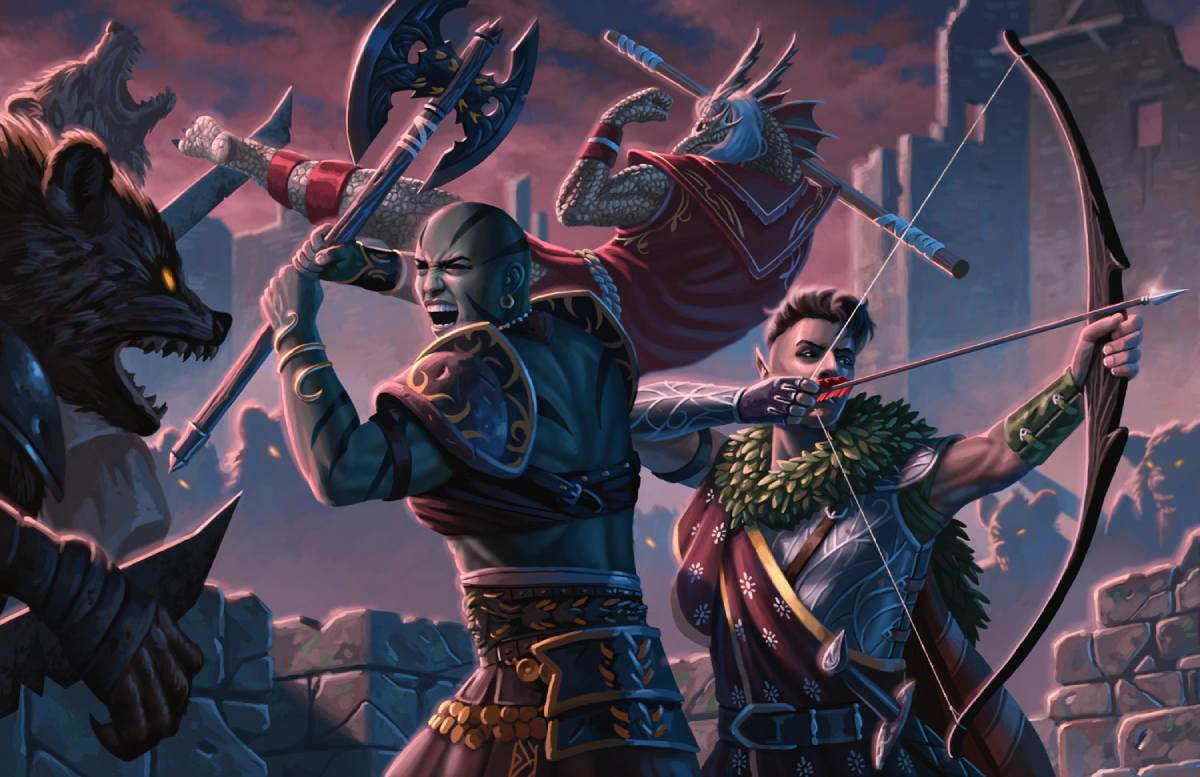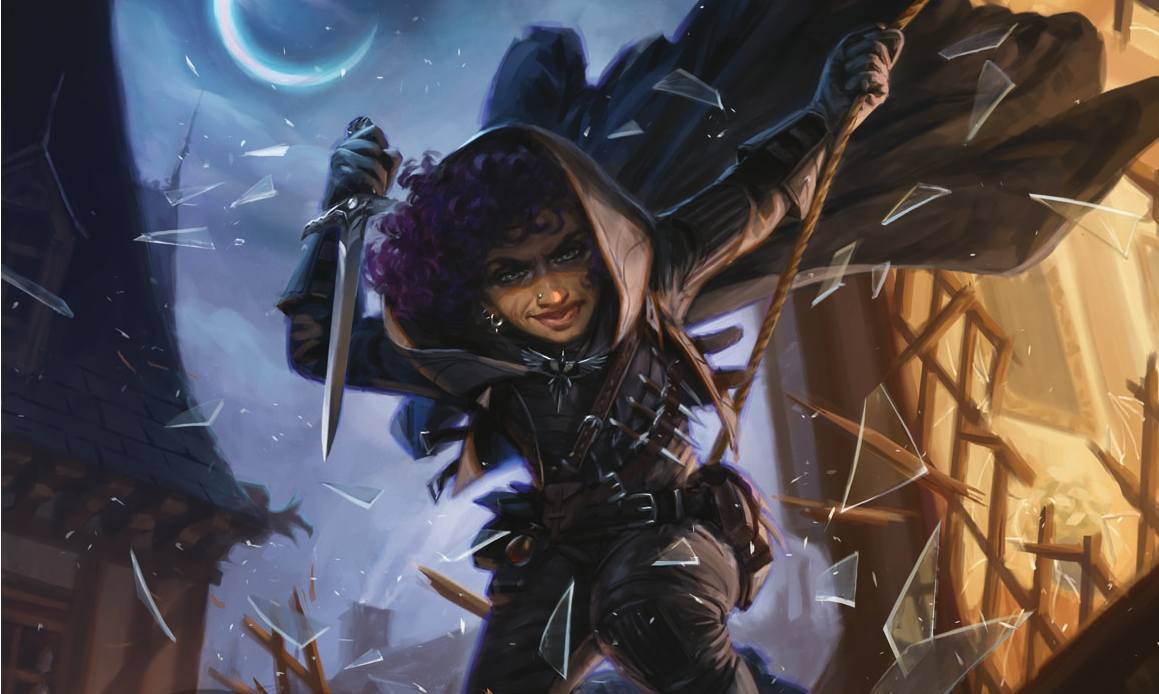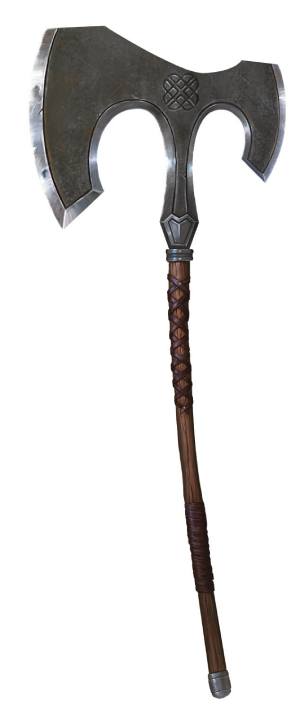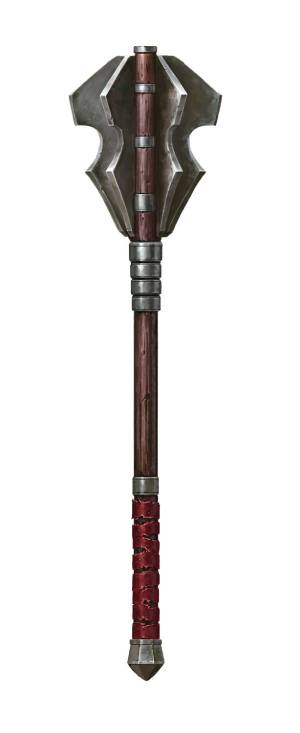The Fighter uses their Maul to knock down their opponent, the Rogue dances around with their Rapier to find their foe’s weak point, and the Barbarian swings a Greataxe through two enemies with a single blow. Every character in D&D has a unique flare they bring to combat, and that’s reflected in the new Weapon Mastery feature in the Player’s Handbook!
Let’s explore these fresh ways to utilize your weapons in the upcoming core rulebook revamp!
Build Your Warrior Today
Start building your weapon-wielding warrior today in D&D Beyond's Character Builder. You can access Weapon Mastery for free using the D&D Beyond Basic Rules, so you can test out this new brand-new system and start cutting a heroic path through your foes!
What is Weapon Mastery?

Weapon Mastery is a class feature shared between some martial classes that reflects their specialization with certain types of weapons.
Each weapon in the Equipment section of the 2024 Player’s Handbook lists a mastery property in addition to the weapon’s regular properties. If the weapon meets the requirements in your class's Weapon Mastery feature, you can learn its mastery property and use it in combat.
But learning a mastery property isn't permanent. If you stumble across a shiny new +1 Longsword and want to learn its mastery properties instead, don’t worry! During a Long Rest, you can practice weapon drills and swap out one of your weapon choices at the end of the rest.
The number of mastery properties you can learn is specified in your class's version of the Weapon Mastery feature. Rogues, rangers, and paladins can only access two mastery properties at a time, whereas barbarians and fighters start with two and three, respectively, and eventually gain access to more mastery properties, as detailed in their Features table.
At level 1, Barbarians, Fighters, Paladins, Rangers, and Rogues get access to the mastery properties for certain types of weapons, as listed below:
- Barbarian: Simple and Martial Melee weapons
- Fighter: Simple and Martial weapons
- Paladin: Based on weapon proficiencies (Simple and Martial weapons)
- Ranger: Based on weapon proficiencies (Simple and Martial weapons)
- Rogue: Based on weapon proficiencies (Simple weapons and Martial weapons with the Finesse or Light property)
Mastering Weapon Mastery
Some subclasses allow you to access more mastery properties. For example, the Soulknife Rogue can use the Vex mastery property with their Psychic Blades and it doesn’t count toward their learned Weapon Mastery limit.
How to Use Weapon Mastery Properties
If you’re wielding a weapon and have learned its mastery property, you’ll be able to use that mastery property every turn when you make an attack with the weapon.
Different mastery properties have different triggers. For example, Cleave requires you to hit a creature with a melee attack roll while Graze triggers when you miss a creature with an attack roll.
Unlike some abilities, there’s no limit to how many times mastery properties can be used per Short or Long Rest, so go nuts!
Mastery Properties Overview

Below, we’ll cover each of the eight mastery properties included in the 2024 Player’s Handbook. We’ll even throw in some tips to help you brainstorm ideas for your new characters!
Cleave

Example Weapon: Greataxe
If you’ll be wading into the thick of battle, you’ll want to consider grabbing a weapon with the Cleave property.
These heavy weapons can slash through opponents. If you hit a creature with a melee weapon attack, you can make a second attack against a creature within 5 feet that is also within your reach. When you hit with the second attack, you can roll your weapon’s damage, but you don’t add your ability modifier unless it’s negative.
This is excellent in combination with the Halberd, which has Reach and Cleave, allowing you to Cleave into enemies in an extended range.
Graze
Example Weapon: Greatsword
Graze is an excellent way to increase the consistency of your weapon damage.
If you miss a creature with your weapon, you deal damage equal to the ability modifier you used to make the roll. This pairs well with abilities that allow you to make a lot of attacks, like the Fighter’s Extra Attacks features or the Polearm Master or Sentinel feats.
It just goes to show that when a weapon is big enough, you don't really need to aim where you're swinging.
Nick
Example Weapon: Dagger
To explain the Nick property, we should briefly cover that being able to attack twice while dual-wielding Light weapons has subtly changed in the 2024 Player’s Handbook. Instead of being covered under Melee Attacks, the rules for dual-wielding Light weapons are covered under the Light weapon property.
It still functions the same way: When you make an attack with a weapon that has the Light property, you can use a Bonus Action to make one attack with a different Light weapon you’re wielding.
The Nick mastery property allows you to make the additional attack you receive from wielding two Light weapons as part of the initial attack action.
Keep in mind that this doesn’t mean you can make a third attack as a Bonus Action, as the Light property specifies you only get one extra attack. But, while it may not pump your damage, this frees up your Bonus Action to use class/species abilities, such as the Rogue’s Cunning Action, while still getting an additional attack in.
Push
Example Weapon: Greatclub
Sometimes giving an enemy a simple shove off a cliff or into a pit of lava is all you need to win an otherwise tough encounter! The Push mastery property allows you to launch a creature you hit 10 feet straight away from you without a save.
Not only is this great when combined with environmental hazards, it's also great for escaping Opportunity Attacks. If you or a less tanky party member are being harassed by an enemy, you can push the enemy 10 feet away, which can allow you to create the space needed to escape unscathed.
Keep in mind that you can only push enemies Large or smaller, so don’t go getting stuck next to an Adult Black Dragon.
Sap

Example Weapon: Mace
If your job is to distract the enemies for long enough to let your blaster caster friends deal with them, Sap is a solid choice.
When you hit an enemy with an attack, this mastery property inflicts Disadvantage on your target’s next attack roll before the start of your next turn.
So, for heavily armored, tanky builds, your enemies will be so focused on trying to take you out that they won’t even see the Fireball coming.
Slow
Example Weapon: Light Crossbow
This mastery property is excellent for fast builds that like to flit across the battlefield. When you hit a creature and deal damage, you can reduce its Speed by 10 feet until the start of your next turn.
This combos excellently with the Light Crossbow, allowing you to take shots, damage your opponents, and then move to just out of range of their reduced Speed. Rinse and repeat until they look like a pin cushion.
It’s important to note that a creature hit more than once by weapons with this property doesn't have its Speed reduced any more than 10 feet. So don’t expect to stand still, hit your enemy three times, and not get caught.
Topple
Example Weapon: Maul
This mastery property is for all those builds that love to wail on their enemies with multiple melee attacks.
When you hit a creature, you can force it to make a Constitution saving throw or fall Prone. The DC for this save is 8 plus the ability modifier used to make the attack plus your Proficiency Bonus.
So, a level 5 Fighter with a Maul could knock their opponent Prone with their first attack, then use their second attack and Action Surge to make multiple attacks with Advantage.
Just remember attacking Prone enemies outside of 5 feet actually gives the attacker Disadvantage on their attack roll. So only use this ability if you or another melee-minded party member can take advantage of it.
Vex
Example Weapon: Shortsword
Having a weapon with Vex feels like a superior swordsman dancing around their opponent, striking at openings until the battle is won.
When you hit a creature and deal damage, this mastery property gives you Advantage on your next attack roll before the end of your next turn. This is an excellent way for Rogues to all but guarantee a Sneak Attack hit on their next turn.
The Student Becomes the Master
The 2024 Player’s Handbook is now available on the D&D Beyond marketplace, which means it's time to set out on new adventures with fresh or familiar characters!
Weapon Mastery is a fun way to give martial characters more choice in combat. It also revamps the way weapons feel in D&D. The new options and revisions presented in this book are a result of a decade of lessons learned and adventures had. With updated rules and streamlined gameplay, it's never been easier to bring your stories to life.
We’re delighted to share with you the changes to fifth edition D&D that appear in the 2024 Player’s Handbook. Make sure to keep an eye out on D&D Beyond for more useful guides on using the wealth of new options, rules, and mechanics found in the 2024 Player's Handbook!

Mike Bernier (@arcane_eye) is the founder of Arcane Eye, a site focused on providing useful tips and tricks to all those involved in the world of D&D. Outside of writing for Arcane Eye, Mike spends most of his time playing games, hiking with his partner, and tending the veritable jungle of houseplants that have invaded his house.
This article was updated on August 12, 2024, to issue corrections or expand coverage for the following features:
- What is Weapon Mastery?: Made clear that the Rogue is proficient with all Simple weapons.
- Slow: Clarified that the Slow property doesn't stack with itself.








-
View User Profile
-
Send Message
Posted Jun 21, 2024Now if there was a mechanism to scale weapon damage with character's levels, and help keep pace with that of spellcasters..
It would be great if the dagger in the hands of a 5th level rogue could deal 1d6 damage (or 2d4 perhaps?), 11th level 1d8 (or 3d4?), instead of remaining 1d4 throughout the game.
I'd appreciate this for the damage output, added parity between high level martial vs magic wielding characters, and the ability to use some different dice as the game progresses as well (poor, neglected d12s)...
-
View User Profile
-
Send Message
Posted Jun 21, 2024Yes weirdly enough, if you prone the target more than 5ft from you, you get disadvantage
-
View User Profile
-
Send Message
Posted Jun 22, 2024Aye, me too!
-
View User Profile
-
Send Message
Posted Jun 22, 2024I would like to use Vex with yklwa.
-
View User Profile
-
Send Message
Posted Jun 22, 2024I've believe I'll include a few changes/additions to weapon mastery for my games. Here are my current thoughts:
At lower levels (1st - 10th) any attack with a Mastered weapon that rolls a natural 18 or 19 rolls double the weapon's damage die (So a longsword that would normally roll 1d8 gets to roll 2d8 on an 18 or 19 that hits, whether the Mastery property/effect is used or not). A 20 that hits gets 1 maxed weapon die and 1 rolled die (So that longsword on a 20 does 1d8 + 8). At levels 11-20, all attacks with Mastered weapons that hit get double their standard weapon dice (2d8 for any Mastered longsword attack that hits, with a nat 20 now doubling that 2d8 to 2d8 rolled +16).
Also, a Magic weapon does +1 on the attack roll and +1d6 of the weapons normal damage type, not just +1. This is borrowed from Pathfinder 2e's potency runes, but I really like it, Some magic weapons instead have another damage type, so the bonus damage is fire, cold, electricity, etc. But I thought regular magic weapons shouldn't be so far behind specific damage type magic weapons... the damage is the same as the regular weapon damage, but it should still do about the same total damage barring weaknesses or resistances.
How does this interact with the weapon mastery change I made above? Not at all. That only affects the weapon's standard damage dice; any bonuses from attributes or magic are added after the dice are rolled. (and are doubled only on a nat 20).
For those looking to scale weapon damage up somewhat at higher levels, I encourage you to give my thoughts here a try! It doesn't advance the weapon's die type to a higher die size, it simply lets you roll additional dice for that weapon due to your mastery with it. I wanted to have something for the lower level characters (hence the nat 18 and 19 rule) as well as something for the higher levels (all attacks that hit now get doubled weapon damage dice from 11th lvl on). Also, note that NPCs and monsters also follow these rules!, not just the PCs! So a Goblin that hits a PC with a nat 19 with a shortsword rolls 2d6. If the monster/villain is CR 11 or higher, double it's weapon damage dice on all attacks that hit! That will make PCs really fear the high level threats. NOTE: All of this is based on the 2014 5e rules, and subject to change if and when I see the 2024 complete rules. Maybe (hopefully!) they've fixed the higher CR monsters to actually be a threat without requiring this change!)
-
View User Profile
-
Send Message
Posted Jun 22, 2024Ah, yes, my favorite game is Dungeons & Anime.
No, it's not. These features give 1st level characters similar power to 4th and 8th level characters who had to actually work for it. And, not only that, but this little snippet goes out of its way to state factually incorrect information. "It just goes to show that when a weapon is big enough, you really don't need to aim where you're swinging." Which, if you've ever picked up and swung a heavy object, you would know is completely false. You actually need BETTER aim to use a larger weapon, otherwise you end up with a lowered guard, a lot of wasted energy and a missed swing. Oh, and don't forget the enemy right in your face.
-
View User Profile
-
Send Message
Posted Jun 22, 2024Do long swords have anything going for them?
-
View User Profile
-
Send Message
Posted Jun 23, 2024What about unarmed builds?
-
View User Profile
-
Send Message
Posted Jun 23, 2024Slow seems like a bad quality to add to a crossbow.
Seems like something you'd add to a net.
-
View User Profile
-
Send Message
Posted Jun 23, 2024Idk
-
View User Profile
-
Send Message
Posted Jun 23, 2024I only saw the weapons
-
View User Profile
-
Send Message
Posted Jun 23, 2024I don't think every weapon types gets a weapon mastery property, for example, what does a long sword get. What a shame and real miss on WotC. If you are going to add a feature like this, make sure every weapon can have some kind of unique ability.
-
View User Profile
-
Send Message
Posted Jun 23, 2024Great Question: I never know that a Glaive had disadvantage on a prone character, that would suck
-
View User Profile
-
Send Message
Posted Jun 23, 2024They did in the play test!
-
View User Profile
-
Send Message
Posted Jun 24, 2024I think it's generally understood that all weapons have a mastery property. I haven't seen the book. but that's what i believe is the case.
-
View User Profile
-
Send Message
Posted Jun 24, 2024Right? This is awesome. I did this with my own weapons for a long time to give players some extra fun with using specific weapons, but this official content is amazing and I am truly excited
-
View User Profile
-
Send Message
Posted Jun 24, 2024They were always cool... lol
-
View User Profile
-
Send Message
Posted Jun 24, 2024More options are nice. But I'm not a fan to give player chacters more power without giving the DM better tools to deal with that power. Especially if you still claim it is compatible with the 5e
-
View User Profile
-
Send Message
Posted Jun 24, 2024I gotcha, yeah it can get pretty hairy giving players a lot of moves and such to try and handle. I have only ever been a DM, and I am the kind of guy who can't help but make my own out of what I am givin, you know. I have yet to play a campaign where I do not end up adding my own elements to make the story meaningful and powerful lol
So I guess what I am trying to say is I am used to managing a lot of different skills and stuff (specially when I geek out about it ;) ), but it is not easy.
I am wondering how this stacks up against monsters and such. Will monsters end up with the same mastery? That would even the score, but again make things more difficult for a DM to manage. I don't know man, personally I think I can handle a little bit of a challenge like that, but I wouldn't nessacarily want that for others. I will think of a way one could make it more managble or something.
-
View User Profile
-
Send Message
Posted Jun 24, 2024Every weapon type has a mastery property.
In the playtest version the Longsword had the "Flex" property, which was only for versatile weapons and let you use the two-handed damage die even when attacking with one hand. Since they didn't mention that one in this article, they may have dropped it in favor of something else. But they did explicitly say in the video that every weapon does have a mastery property.